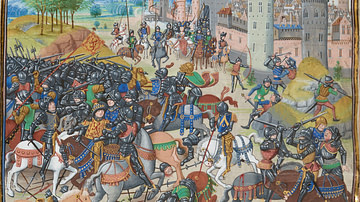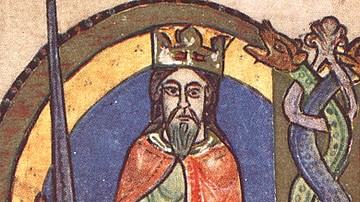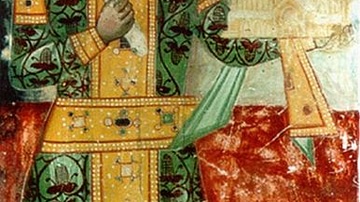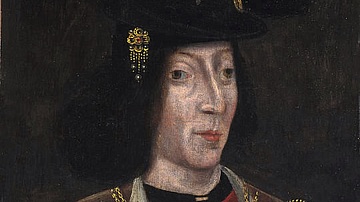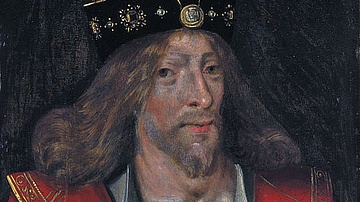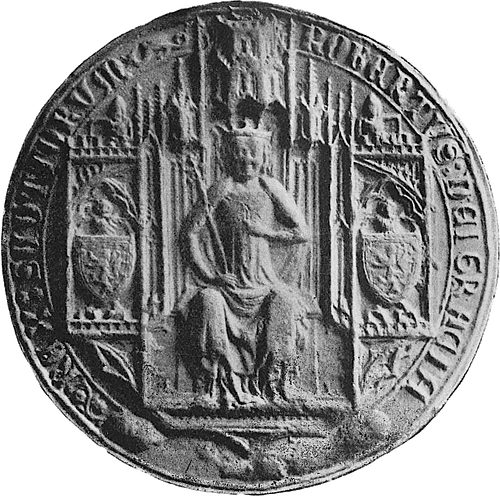
Robert II of Scotland ruled as king from 1371 to 1390. Born Robert Stewart, he succeeded the heirless David II of Scotland (r. 1329-1371) and so founded the royal house of Stewart. Dividing Scottish estates between his many offspring, Robert redrew the political map of his kingdom and effectively replaced half of the nobility with his family and allies, a process often called the 'Stewartisation' of Scotland. Although a more capable leader in his youth than medieval historians liked to portray him, Robert's reign did witness a decline in the wealth of the Crown and the creation of bitter rivalries amongst the great baronial families which would cause no end of problems for his successor, his son Robert III of Scotland (r. 1390-1406).
Early Life
Robert Stewart was born on 2 March 1316 in Paisley in exceptional circumstances. His mother was involved in a fatal riding accident, and Robert was born by Caesarian section. Robert's mother was Marjorie (b. c. 1295), daughter of King Robert the Bruce (r. 1306-1329) and Isabel of Mar. This made Robert the nephew of David II of Scotland, even if he was several years older. Robert's father was Walter Stewart, a powerful Scottish baron. The family name was a subtle alteration of 'Steward', a title Robert's family had held since the 12th century in their capacity as the hereditary Great Stewards of Scotland. Robert's father was the 6th High Steward of Scotland, by then a purely honorary title. On his father's death in 1327, Robert became the next Steward and the owner of estates which gave him a rank equal with the most powerful families in the kingdom such as the Bruces and the Douglases.
Robert spent most of his childhood on the west coast of Scotland. Aged just 17, he fought at the Battle of Halidon Hill on 19 July 1333. The battle saw Edward III of England (r. 1327-1377) heavily defeat a Scottish army. Robert, along with other nobles, fled to the safety of Dumbarton, but he then launched a sustained campaign to retrieve some of his family's lost castles and estates.
One medieval chronicler gives the following description of Robert: "a young man of attractive appearance above the sons of men, broad and tall in physique, kind to everyone, and modest, generous, cheerful and honest" (Oram, 143). Robert married his mistress Elizabeth Mure in 1336 (and again after the 1347 papal dispensation which finally declared their union valid). Around 1337 (or in 1340) Robert had his first son, John. Elizabeth died sometime before 1355, and Robert married again in May of the same year, this time to Euphemia, Countess of Moray. Robert would go on to have another 21 children, both legitimate and illegitimate. John, though, was made the official heir apparent in 1371.
Regency for David II
David II had succeeded his father Robert the Bruce, but as he was a minor, his kingdom was ruled by a guardian. Robert Stewart became that guardian in 1338. The young king also faced a rival claimant, Edward Balliol (c. 1283-1364), son of King John Balliol (r. 1292-1296). Edward had the support of Edward III of England and so was able to briefly grab the Scottish throne twice (1332 and 1333-1336). David II was consequently forced into exile in France, but he returned in 1341. Upon his return, David had to contend with Robert Stewart who had established himself as one of the foremost nobles in the kingdom. Robert had made good use of the chaotic musical thrones between Balliol and David, greatly expanding his own estates and establishing a useful network of allies across Scotland. Robert had also managed to reclaim Edinburgh Castle from its English garrison and put Stirling Castle under a heavy siege.
In 1346, King David unwisely attacked northern England and he was infamously captured at the Battle of Neville's Cross. English archers had brought victory, and the Scots had suffered significant desertions, notably Robert Stewart who withdrew as soon as the battle had tipped in favour of the enemy. The Scottish king spent the next 11 years in the Tower of London, and in his absence, Robert rose to effectively rule Scotland as regent and become the king's heir apparent.

The Balliols still had powerful and numerous supporters, but so, too, did David II, even while he was languishing in prison. Many Scots remained loyal to their king and had no desire to see a puppet of Edward III on their throne. Edward Balliol had even promised the English king he would be his vassal and hand over vast swathes of southern Scotland. David II also had important support from abroad, most notably the King of France, Philip VI of France (r. 1328-1350). However, Robert Stewart, now calling himself the King's Lieutenant, seemed in no particular hurry to gather the enormous ransom Edward III demanded for David's release.
Over the years of the king's confinement, Stewart and several Scottish parliaments had steadfastly refused to acknowledge King David's request to nominate the English royal family as the heirs of Scotland if he himself had no heir and so escape paying such an onerous ransom. Robert Stewart's regency was characterised by much infighting between Scottish nobles and terrible neglect for the state's finances. Neither was the lot of the Scottish people in any way helped by the arrival of the Black Death plague which eventually killed 25-30% of the population.
David II's Return
David II was finally released in October 1357 as part of the Treaty of Berwick, where the Scots agreed to pay a ransom and respect a 10-year truce with England. Robert Stewart remained a dangerous rival, though, and despite being made the earl of Strathearn by his king, he made an unsuccessful attempt at a coup. Indeed, it was not until 1363 that he finally gave formal submission to his king. Despite the friction between the two, Robert remained David's heir presumptive for want of a better candidate. The remainder of David's reign saw some prosperity return to Scotland, but the king failed in the one area that all medieval kings could not afford to neglect if peace were to be sustained: to produce an heir.
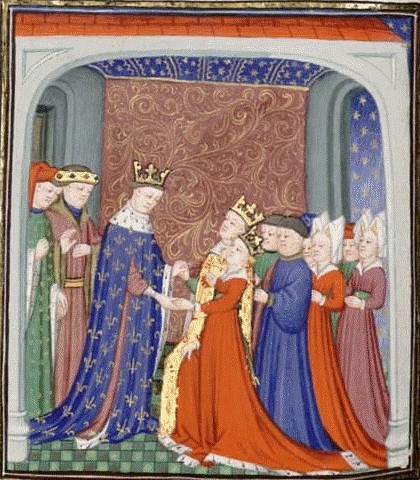
Succession & Stewartisation
When David II died on 22 February 1371 he left no heir and so Robert Stewart was made king as Robert II of Scotland. Robert was then 55, and he had secured his right to the throne by buying off his chief rival Earl William Douglas. Thus was founded the royal house of Stewart (later to become Stuart) which would rule Scotland until 1603 and after that both England and Scotland together. Robert's coronation was held at Scone Abbey on 26 March 1371. The new king quickly gave lands, annuities, and pensions to loyal followers, gave titles and estates to his many male offspring (legitimate or otherwise), and married off his daughters to link the royal family to other powerful dynasties. Some historians have called this strategy the 'Stewartisation' of the nobility, and its consequences were that the Stewarts controlled half of Scotland's earldoms. Many of these royal nobles proved to be uncontrollable, most notably Alexander Stewart, the 'Wolf of Badenoch', who ruthlessly exploited his estates and wilfully ignored the laws of the land. To further legitimise his right to rule, Robert also set about fabricating a history of a unified Scotland with his grandfather Robert the Bruce as its greatest hero, even commissioning the celebrated poem The Bruce by John Barbour.
Although the first part of Robert's reign saw much continuity in both officials and policies, the state's finances began to seriously decline from the mid-1370s. The wool trade, which provided lucrative customs duties for the Crown, had boomed in the previous two decades, but by 1390, it had halved. Direct taxation had ended in 1373, and sheriffs - responsible for tax collection - avoided the exchequer as parts of Scotland became increasingly lawless while Stewart barons only looked after their own interests.
In terms of foreign policy, Robert first set about reclaiming parts of southern Scotland his predecessors had lost to England. The king, perhaps pressurised by Scotland's old ally France, then launched several attacks on northern England and won a celebrated victory in August 1388 at the battle of Otterburn. The victory was made all the sweeter because the English army had been led by the celebrated medieval knight Sir Henry 'Hotspur' Percy (1364-1403). Robert did not lead his armies in person, and as neither the Scottish nor French leaders could agree on a strategy to face England, an uneasy truce was re-established between Scotland and England.
Towards the end of his reign, Robert seemed unenthusiastic about politics, leaving most matters of government to his eldest son John, Earl of Carrick while he retired to a favourite residence like Rothesay Castle on the Isle of Bute. John, with the backing of Earl James Douglas (son of William Douglas and the new leader of that clan), had even launched a coup against his father in 1384 but eventually settled down to rule Scotland in practice if not in title.
Death & Successor
Robert died on 19 April 1390 at Dundonald Castle in Ayrshire, and he was buried at Scone Abbey. Robert was succeeded by his eldest son who became Robert III of Scotland. The name John was considered inappropriate as the Bruces' great rivals the Balliol's had had a king of that name, and it was also thought an unlucky one for a Scottish monarch. Any attempts to gain fortune's favour was already a bit late as John/Robert had been kicked by a horse in 1388 and so spent the rest of his days as an invalid. Robert III was thus obliged to largely leave the government in the hands of others, notably his brother Robert, Earl of Fife (aka Duke of Albany, l. 1339-1420).
Robert III's kingdom was torn by the bitter rivalries which had been created by Robert II's land and title redistribution policies and his large number of offspring. The inherent instability in the kingdom was seen most infamously at the clan battle at Perth in 1396 where a number of Mackays and Mackintoshes fought each other to the death. More seriously for Scotland, England once more went on the offensive against its northern neighbour, but, still, the Stewarts continued to hold on to power, and the house Robert II had founded would rule Scotland until 1714.



